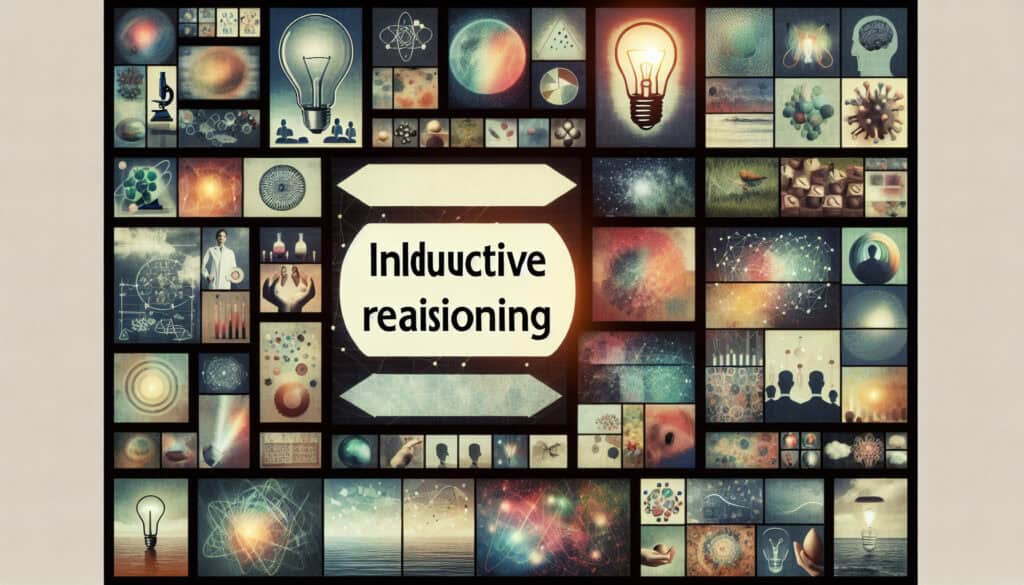Tirer des conclusions générales à partir d'observations spécifiques.
- Méthodologies : Économie, Lean Sigma, Fabrication, Résolution de problèmes, Qualité
Raisonnement inductif

Raisonnement inductif
- Méthodologie Agile, Pensée conceptuelle, Innovation, Techniques de résolution de problèmes, Contrôle de qualité, Gestion de la qualité, Recherche et développement, Statistical Analysis, Contrôle statistique des processus (CSP)
Objectif :
Comment il est utilisé :
- Processus logique dans lequel de multiples prémisses, toutes considérées comme vraies ou considérées comme vraies la plupart du temps, sont combinées pour obtenir une conclusion spécifique. Elle est souvent utilisée dans la recherche et la résolution de problèmes pour élaborer des hypothèses et des théories.
Avantages
- Permet de développer de nouvelles théories et hypothèses ; peut être un puissant outil de découverte.
Inconvénients
- Les conclusions sont probabilistes et peuvent ne pas être certaines ; elles peuvent être sujettes à des biais et à des erreurs.
Catégories :
- Idéation, Résolution de problèmes
Idéal pour :
- Développer de nouvelles hypothèses et théories dans le cadre de la recherche scientifique et de la résolution de problèmes.
Le raisonnement inductif est souvent appliqué au cours des premières phases de la conception et de l'innovation des produits dans des secteurs tels que la technologie, les produits pharmaceutiques et les biens de consommation. Par exemple, les équipes de développement de produits peuvent analyser les réactions des utilisateurs, les tendances du marché et les solutions existantes afin de dégager des modèles qui serviront de base à la conception de nouvelles fonctionnalités ou de nouveaux produits. Dans le domaine de la recherche, les scientifiques utilisent le raisonnement inductif lorsqu'ils collectent des données expérimentales, à la recherche de tendances susceptibles de déboucher sur de nouvelles hypothèses, comme la découverte d'un nouveau composé médicamenteux sur la base des effets observés de produits chimiques apparentés. Les initiatives qui nécessitent la collaboration d'équipes interfonctionnelles, notamment de concepteurs, d'ingénieurs et de spécialistes du marketing, bénéficient de cette méthodologie, car elle stimule le brainstorming créatif et encourage la diversité des points de vue. Les participants à ce processus peuvent être des chercheurs, des gestionnaires de produits et des utilisateurs finaux, dont les expériences apportent des connaissances précieuses pour formuler des hypothèses. La nature itérative de ce raisonnement permet aux équipes d'affiner les idées par le biais de tests et de retours d'information continus, garantissant ainsi l'alignement sur les besoins des utilisateurs et les demandes du marché. En synthétisant les observations collectives en idées exploitables, les équipes améliorent le potentiel d'innovations révolutionnaires, faisant progresser à la fois les connaissances scientifiques et les applications pratiques.
Principales étapes de cette méthodologie
- Identifier des tendances ou des modèles dans les observations recueillies.
- Générer des hypothèses sur la base des modèles observés.
- Tirer des conclusions spécifiques à partir des hypothèses émises.
- Tester les conclusions par une expérimentation systématique.
- Affiner ou réviser les hypothèses sur la base des résultats des tests.
- Intégrer les hypothèses révisées dans des cadres théoriques plus larges.
Conseils de pro
- Utiliser des études de cas pour identifier des modèles et déduire des corrélations potentielles dans le comportement des utilisateurs ou la performance des produits.
- Incorporer des données qualitatives provenant d'entretiens et d'enquêtes afin d'enrichir le raisonnement inductif et d'approfondir la formation d'hypothèses.
- Répéter les hypothèses sur la base des boucles de rétroaction des phases d'essai, ce qui permet d'affiner en permanence les théories dérivées des observations.
Lire et comparer plusieurs méthodologies, nous recommandons le
> Référentiel méthodologique étendu <
ainsi que plus de 400 autres méthodologies.
Vos commentaires sur cette méthodologie ou des informations supplémentaires sont les bienvenus sur le site web de la Commission européenne. section des commentaires ci-dessous ↓ , ainsi que toute idée ou lien en rapport avec l'ingénierie.
Contexte historique
1687
1687
1750
1788
1800
1800
1800
1678
1687
1738
1757
1788
1800
1800
1800
(si la date est inconnue ou n'est pas pertinente, par exemple "mécanique des fluides", une estimation arrondie de son émergence notable est fournie)















Articles Similaires
Gestion des opérations de fabrication (MOM)
Système d'exécution de la fabrication (MES)
Plan de contrôle de la fabrication
Tests manuels
Tableaux d'évaluation des manutentions manuelles (MAC)
ManTRA (outil d'évaluation des risques liés aux tâches manuelles)